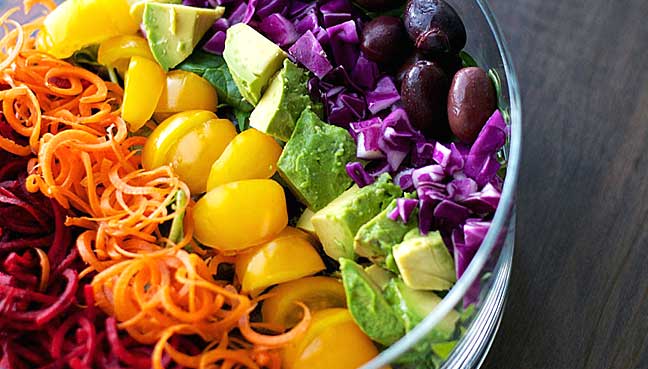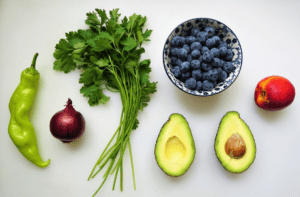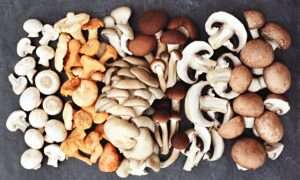One of the best things you can do to extend your healthspan (time spent not just alive, but healthy) is to increase produce. About 2/3 of our plate at any given meal consists of vegetables or fruit, but I didn’t drastically change our usual family recipes to increase the amount of vegetables – I just employed a few tweaks. The key here is using addition rather than substraction to change your habits.
#1. Add riced cauliflower to your meals.
For example, I get the steam-in-bag riced cauliflower and add it to rice, other grains, soups, and even smoothies. It’s virtually undetectable, so it’s a great way to get kids to eat more cruciferous vegetables too. You can also rice a whole head of cauliflower: cut it into medium sized florets and chunks, fill the bottom of a blender with about 2 cups of water so the florets will float off the blades, and pulse until they process into rice-like pieces. I just use the prepared option to minimize effort and maximize the likelihood I add more vegetables.

Pro Tip: Also makes a great tabbouleh salad with some kalamata olives, parsley, diced tomatoes, and other spices. Add chickpeas for a full lunch!
#2. Add frozen (or fresh) vegetable blends to cooking pasta a few minutes before you drain.
I like to do this with broccoli or “California blend” with cauliflower and broccoli florets and sliced carrots, particularly with penne or rigatoni pasta. Broccoli in particular holds pasta sauce really nicely, as does kale. Spiralized zucchini is also great addition to spaghetti and can be purchased pre-spiralized and frozen.
Not sure what main dishes to add vegetables to? See the complete recipe list here >>
Pro Tip: Choose whole grain or legume-based pasta: the Banza brand chickpea pastas are especially good.
#3. Add shredded cabbage or coleslaw blends to everything
Add shredded cabbage to everything from ramen to stir fries. Coleslaw is super cheap, and sometimes contains carrots as well – it’s convenient because it’s already finely shredded and requires only a bit of cooking if you’re not using in a salad. Our son loves Chef Woo plant-based high protein ramen, and I always add a good 1/4 cup of coleslaw blend before microwaveing when I prepare it for him. Yes, I know that ramen isn’t the most nutritious food on the planet; yes, I know that microwaved meals aren’t as tasty as stovetop-prepared meals. The point here is not to achieve perfection, but to simply add vegetables to imperfect food.
If we order Chinese food, I will often stir fry a bunch of shredded cabbage or green beans to add to the food.
If I need an easy raw salad as a side that the kids will actually eat, I add vegan mayo, vinegar, celery seed, salt and pepper to it to make coleslaw.
According to the USDA Economic Research Service, potatoes, tomatoes, and lettuce make up close to 60 percent of U.S. vegetable and legume availability. The goal here is to add variety. Prepared vegetable blends make it easy to achieve this.

Pro Tip: Not everyone in your family may support your new habit of adding vegetables to the foods they were used to right away. That’s okay, just stay committed to their health and yours. You can always start with small amounts. They’ll get on board eventually.
#4. Extend your takeout meals and add fiber with vegetables.
Takeout has become ridiculously expensive. It’s hard, at least for me, to justify spending $50 on a takeout meal unless it’s (a) a large amount of food or (b) generates leftovers. Also (c), I would hope it doesn’t make me feel like crap because it has minimal vegetables and fiber. A strategy that addresses all three of these issues is adding more vegetables! For example, we order Thai food takeout every Sunday. We always get mock duck red curry, and while this amazing curry sauce arrives in large quantity it comes with a tiny amount of vegetables and a half-filled container of rice. I put a steamer basket in an 8 quart stockpot and fill it to the brim with:
- 10 oz of baby carrots
- 1/4 head of cabbage, chopped
- vegetables from the garden when available (eggplant, green beans, tomatoes, Thai basil)
- 10 oz frozen broccoli and, sometimes
- 10 oz frozen cauliflower
With the addition of these vegetables, we can eat a massive dinner and still have enough left over for two small lunches. If we get Indian or Chinese food, I will often stir fry extra coleslaw blend or add cauliflower rice using two of the strategies mentoned above. Italian food benefits from the addition of a fresh side salad.
Pro Tip: Always include a frozen vegetable blend or two, frozen riced cauliflower, and a bag of shredded kale or coleslaw on your grocery list to add to your meals.
#5. Add vegetable blends to your grocery list
A huge pitfall to setting out to improve your diet is the infamous grocery list makeover.
It’s easy to burn out or give up if you think to re-learn how to cook and accumulate a whole new arsenal of recipes and associated shopping lists. For now, just add to your existing habitual grocery purchases:
- a frozen vegetable blend, like California blend, or broccoli and cauliflower
- frozen riced cauliflower or a head of fresh to rice yourself
- a bag of shredded kale or coleslaw
And remember, once it becomes a habit to grab a handful of veggies to toss in as you cook, you are set for life. It will seem bizarre to eat a sad, beige meal with no color.



